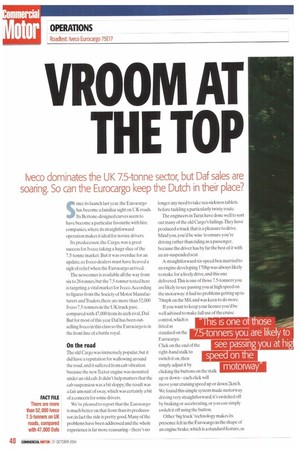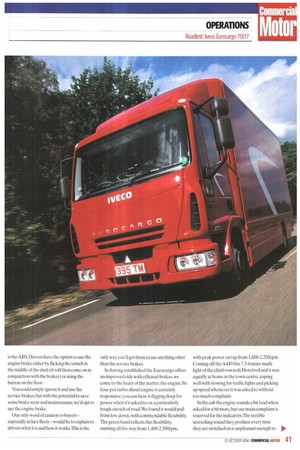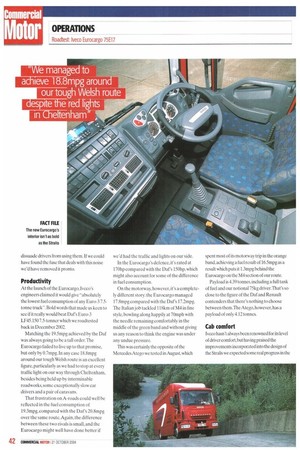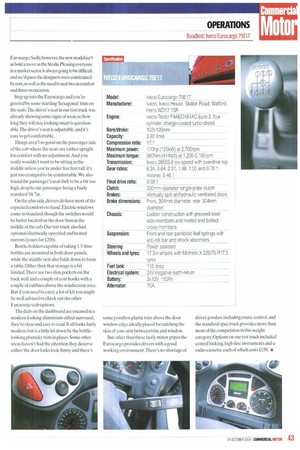1f110011111 AT THE TOP
Page 42

Page 43

Page 44

Page 45

If you've noticed an error in this article please click here to report it so we can fix it.
Iveco dominates the UK 7.5-tonne sector, but Daf sales are soaring. So can the Eurocargo keep the Dutch in their place?
Since its launch last year, the Eurocargo has become a familiar sight on UK roads. Its Bertone-designed curves seem to have become a particular favourite with hire companies, where its straightforward operation makes it ideal for novice drivers.
Its predecessor, the Cargo, was a great success for Iveco, taking a huge slice of the 7.5-tonne market. But it was overdue for an update,so Iveco dealers must have heaved a sigh of relief when the Eurocargo arrived.
The newcomer is available all the way from six to 26 tonnes, but the 7.5-tonner tested here is targeting a vital market for Iveco. According to figures from the Society of Motor Manufacturers and Traders, there are more than 52,000 Iveco 7.5-tonners in the UK truck parc, compared with 47.000 from its archrival, Dal. But for most of this year Daf has been outselling Iveco in this class so the Eurocargo is in the front line of a battle royal.
On the road The old Cargo was immensely popular, but it did have a reputation for wallowing around the road, and it suffered from cab vibration because the newTector engine was mounted under an old cab, It didn't help matters that the cab suspension was a bit sloppy; the result was a fair amount of sway, which was certainly a bit of a concern for some drivers.
We're pleased to report that the Eurocargo is much better on that front than its predecessor; in fact the ride is pretty good. Many of the problems have been addressed and the whole experience is far more reassuring — there's no longer any need to take sea-sickness tablets before tackling a particularly twisty route.
The engineers in Turin have done well to sort out many of the old Cargo's failings. They have produced a truck that is a pleasure to drive. Mind you, you'd be wise to ensure you're driving rather than riding as a passenger, because the driver has by far the best of it with an air-suspended seat.
A straightforward six-speed box married to an engine developing 170hp was always likely to make for a lively drive, and this one delivered.This is one of those 7.5-tonners you are likely to see passing you at highspeed on the motorway: it had no problems getting up to 70mph on the M4, and was keen to do more.
If you want to keep your licence you'd be well advised to make full use of the cruise control, which is fitted as standard on the Eurocargo. Click on the end of the right-hand stall( to switch it on, then simply adjust it by clicking the buttons on the stalk up or down— each click will move your cruising speed up or down 2km/h. We found this simple system made motorway driving very straightforward; it's switched off by braking or accelerating, or you can simply switch it off using the button.
Other 'big truck' technology makes its presence felt in the Eurocargo in the shape of an engine brake, which is a standard feature, as
is is one o those 75-tonners you are likely to motorway
is the ABS. Drivers have the option to use the engine brake either by flicking the switch in the middle of the dash (it will then come on in conjunction with the brakes) or using the button on the floor.
You could simply ignore it and use the service brakes, but with the potential to save some brake wear and maintenance, we'd opt to use the engine brake.
Our only word of caution to buyers — especially in hire fleets — would be to explain to drivers what it is and how it works. This is the only way you'll get them to use anything other than the service brakes.
So having established the Eurocargo offers an improved ride with efficient brakes, we come to the heart of the matter: the engine. Its four-pot turbo-diesel engine is certainly responsive; you can hear it digging deep for power when it's asked to on a particularly tough stretch of road. We found it would pull from low down, with commendable flexibility. The green band reflects this flexibility, running all the way from 1,400-2,500rpm, with peak power on tap from 1,600-2,200rpm. Coming off the A449 this 7.5-tonner made light of the climb towards Hereford and it was equally at home in the town centre, coping well with slowing for traffic lights and picking up speed whenever it was asked to without too much complaint.
In the cab the engine sounds a bit loud when asked for a bit more, but our main complaint is reserved for the indicators.The terrible screeching sound they produce every time they are switched on is unpleasant enough to dissuade drivers from using them. If we could have found the fuse that deals with this noise we'd have removed it pronto.
Productivity
At the launch of the Eurocargo,Iveco's engineers claimed it would give "absolutely the lowest fuel consumption of any Euro-3 7.5tonne truck". Bold words that made us keen to see if it really would beat Daf's Euro-3 LF45.150 7.5-tonner which we roadtested back in December 2002.
Matching the 19.5mpg achieved by the Daf was always going to be a tall order.TIne Eurocargo failed to live up to that promise, but only by 0.7mpg. In any case 18.8mpg around our tough Welsh route is an excellent figure, particularly as we had to stop at every traffic light on our way through Cheltenham, besides being held up by interminable roadworks, some exceptionally slow car drivers and a pair of caravans.
That frustration on A-roads could well be reflected in the fuel consumption of 19.3mpg, compared with the Daf's 20.8mpg over the same route. Again, the difference between these two rivals is small, and the Eurocargo might well have done better if we'd had the traffic and lights on our side.
In the Eurocargo's defence, it's rated at 170hp compared with the Daf's 150hp, which might also account for some of the difference in fuel consumption.
On the motorway, however, it's a completely different story: the Eurocargo managed 17.8mpg compared with the Des 17.2rripg. The Italian job tackled 118km of M4 in tine style, bowling along happily at 70mph with the needle remaining comfortably in the middle of the green band and without giving us any reason to think the engine was under any undue pressure.
This was certainly the opposite of the Mercedes Atego we tested in August, which spent most of its motorway trip in the orange band,achieving a fuel result of 16.5mpg as a result which puts it 1.3mpg behind the Eurocargo on the M4 section of our route.
Payload is 4.39 tonnes. including a full tank of fuel and our notional 75kg driver.That's so close to the figure of the Daf and Renault contenders that there's nothing to choose between thern.The Atego, however, has a payload of only 4.12 tonnes.
Cab comfort
Iveco hasn't always been renowned for its level of driver comfort, but having praised the improvements incorporated into the design of the Stralis we expected some real progress in the Eurocargo.Sadly,however,the new model isn't as bold a move as the Stralis. Pleasing everyone in a market sector is always going to be difficult. and we'd guess the designers were constrained by cost,as well as the need to seat two in comfort and three on occasion.
Step up into the Eurocargo and you're greeted by some startling 'hexagonal' trim on the seats. The driver's seat in our test truck was already showing some signs of wear, so how long they will stay looking smart is questionable.The driver's seat is adj ustable. and it's easy to get comfortable.
Things aren't so good on the passenger side of the cab where the seats are rather upright for comfort with no adjustment.And you really wouldn't want to be sitting in the middle unless you're under five feet tall: it's just too cramped to be comfortable. We also found the passenger's seat-belt to be a bit too high, despite our passenger being a fairly standard 5ft 7in.
On the plus side, drivers do have most of the expected comforts to hand. Electric windows come as standard. though the switches would be better located on the door than in the middle of the cab. Our test truck also had optional electrically operated and heated mirrors (yours for £200).
Bottle-holders capable of taking 1.5-litre bottles are mounted in both door panels, while the middle seat also folds down to form a table. Other than that storage is a bit limited.There are two slim pockets on the back wall and a couple of coat hooks with a couple of cubbies above the windscreen area. But if you need to carry a lot of kit you might be well advised to check out the other Eurocargo cab options.
The dials on the dashboard are encased in a modern-looking aluminium-effect surround; they're clear and easy to read. It all looks fairly modern, but is a little let down by the brittlelooking plasticky trim in places. Some other areas haven't had the attention they deserve either: the door locks look flimsy and there's some pointless plastic trim above the door window edge, ideally placed for catching the skin of your arm betwee n trim and window.
But other than these fairly minor gripes the Eurocargo provides drivers with a good working environment.There's no shortage of driver goodies, including cruise control, and the standard-spec truck provides more than most of the competition in this weight category. Options on our test truck included central locking, high-line instruments and a radio-cassette, each of which costs £150. •


































































































































































































